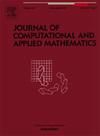漂移扩散方程的节点保界不连续Galerkin方法
IF 2.1
2区 数学
Q1 MATHEMATICS, APPLIED
Journal of Computational and Applied Mathematics
Pub Date : 2025-04-24
DOI:10.1016/j.cam.2025.116670
引用次数: 0
摘要
本文介绍并分析了离散扩散模型的不连续伽辽金(dG)方法。我们探讨了两个dG的表达式:一个经典的内罚方法和一个节点保界方法。虽然内罚方法具有适定性和收敛性,但不能保证解的非负性。为了解决这一缺陷,这在应用中通常是重要的,我们采用了基于凸子集公式的正性保持方法,确保解在拉格朗日节点处的非负性。我们通过总结大量的数值实验来验证我们的发现,强调我们的方法在处理电荷载流子传输的复杂性方面的新颖性和有效性。本文章由计算机程序翻译,如有差异,请以英文原文为准。
A nodally bound-preserving discontinuous Galerkin method for the drift–diffusion equation
In this work, we introduce and analyse discontinuous Galerkin (dG) methods for the drift–diffusion model. We explore two dG formulations: a classical interior penalty approach and a nodally bound-preserving method. Whilst the interior penalty method demonstrates well-posedness and convergence, it fails to guarantee non-negativity of the solution. To address this deficit, which is often important to ensure in applications, we employ a positivity-preserving method based on a convex subset formulation, ensuring the non-negativity of the solution at the Lagrange nodes. We validate our findings by summarising extensive numerical experiments, highlighting the novelty and effectiveness of our approach in handling the complexities of charge carrier transport.
求助全文
通过发布文献求助,成功后即可免费获取论文全文。
去求助
来源期刊
CiteScore
5.40
自引率
4.20%
发文量
437
审稿时长
3.0 months
期刊介绍:
The Journal of Computational and Applied Mathematics publishes original papers of high scientific value in all areas of computational and applied mathematics. The main interest of the Journal is in papers that describe and analyze new computational techniques for solving scientific or engineering problems. Also the improved analysis, including the effectiveness and applicability, of existing methods and algorithms is of importance. The computational efficiency (e.g. the convergence, stability, accuracy, ...) should be proved and illustrated by nontrivial numerical examples. Papers describing only variants of existing methods, without adding significant new computational properties are not of interest.
The audience consists of: applied mathematicians, numerical analysts, computational scientists and engineers.

 求助内容:
求助内容: 应助结果提醒方式:
应助结果提醒方式:


